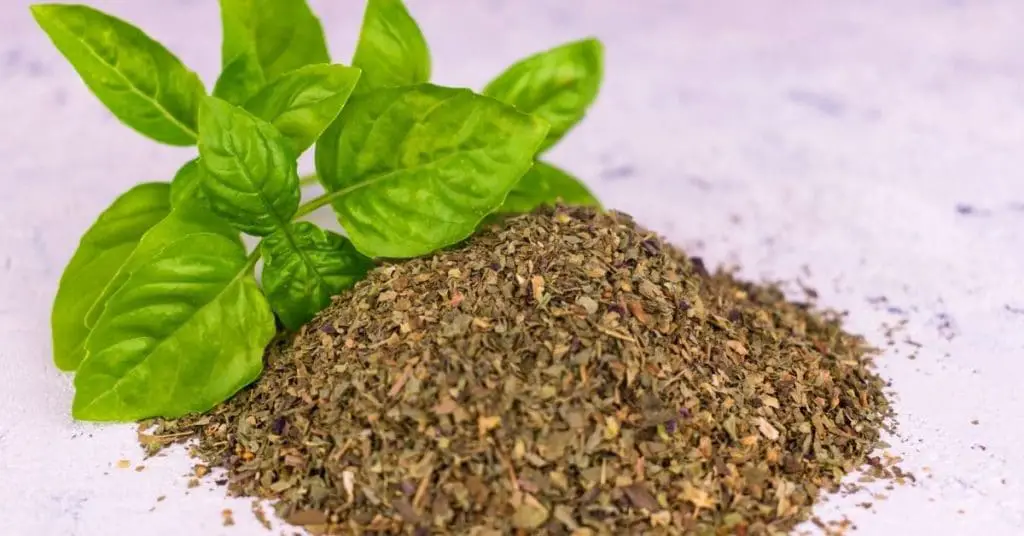In short, there are two methods to dry fresh basil leaves: air-drying and oven-drying. Both methods require cleaning the leaves and storing them in an airtight container after they are dry and crumbled.
Basil is a deliciously fragrant culinary herb used predominantly in savory cooking. The herb can be used fresh or dried to flavor a variety of dishes including pizza, sauces, salad, pasta, stew, and pesto.
Once harvested, fresh basil only lasts for 2 to 5 days in the refrigerator. If you know you can’t use the entire stash of basil from your herb garden before it starts to wilt, dry it instead. This way you can save your basil from going to waste and use it for months to come.
There are a few steps to ensure your basil dries properly and does not end up spoiling.
Here is a step-by-step guide to drying fresh basil leaves.
Can You Dry Basil Leaves?
Yes, you can make your own dried basil to prolong its shelf life. There are several ways to dry herbs including air-drying, using a food dehydrator, and oven methods.
Using heat-drying methods (such as drying basil in the oven) may cause some loss of flavor. Therefore, you might need to use slightly more oven dried basil in recipes than usual to get a pronounced basil flavor.
When drying basil leaves, it is important to make sure that excess moisture is completely eliminated before packing as mold will develop if moisture is present.
How To Dry Basil Leaves
Regardless of the method you choose to dry basil, you will need to clean the leaves first.
Cleaning: Wash and Dry
Step 1: Trim
Basil leaves are the most fragrant when all the leaves are fully grown, but flowers have not yet appeared. This is the best time to harvest basil for optimal flavor.
Once you have harvested bunches of basil, cut the leaves from the main stem. Leave a small length of stem on each leaf, so you can bundle and tie a few leaves together without damaging the leaf surface. Discard any yellow or blemished leaves.
Step 2: Wash Basil
Rinse the basil leaves well in a bowl of cool water. This will remove dirt, chemicals, and small insects. Dry them in a salad spinner if you have one. Then, place the leaves on a clean paper towel or kitchen towel and pat them dry lightly. Removing excess water is imperative to preventing the growth of mold during drying.
Decide whether you want to air-dry or oven-dry the basil and follow the instructions below accordingly. Air-drying basil will take longer to dry. Oven drying is quicker, but you may risk some loss of flavor.
Option 1: Air-Dry
Step 3: Tie Bundles
Keep a few twist ties handy. Gather small bunches of basil leaves and tie the stems together with a twist tie to form bundles.
Step 4: Hang
Hang the bundles of basil leaves to dry from a hook or wall tack. Choose a place with indirect sunlight and good air circulation for effective drying. After around 2 weeks the leaves should be dark green, dry, and brittle. Direct sunlight will cause them to turn black or dark brown.
If the leaves are not completely dry and are still moist or flexible, let the basil dry for another week. When completely dry, they should break easily when you handle them.
Tip: When drying herbs by hanging, you can protect them from dust and direct sun by covering them with a loose paper bag. Leave the bottom open and cut small holes if necessary to ensure good airflow.
Step 5: Store
Working over a bowl, remove the twist tie carefully from the bundle. Crumble the dried leaves into small pieces with your hands. They should crumble easily. You can store the dried basil leaves whole, however, the smaller pieces are more palatable when incorporated into cooked dishes.
Store the dried, crushed herbs in a jar or airtight container with a lid and label it with the date and contents.
Option 2: Oven-Dry
Here’s how to go from fresh basil to dried:
Step 3: Preheat Oven
Set your oven to the lowest temperature setting to heat up (around 200°F/93°C).
Step 4: Prepare Leaves
When drying leaves in the oven, remove the stems completely. Take the cleaned individual basil leaves and lay them out on a baking sheet lined with parchment paper. Make sure the fresh leaves are spread out in a single layer so that they do not overlap each other.
Step 5: Bake
Place the baking sheets in the preheated oven and bake for 20 minutes. Do not open the oven door. Turn the oven off and leave the basil inside the warm oven overnight.
The leaves should be dry in the morning and crumble when pinched between your fingers. If the leaves are not yet completely free of moisture, heat up the oven again. Switch it off once it reaches temperature (200 °F/93 °C) and leave the basil in the warm oven to dry further.
Step 6: Store
Once dry, let the herbs cool completely. Crush the dried herbs by hand or by giving them a quick blitz in a food processor. Store dried basil in a resealable plastic bag, spice bottle, glass jar, or airtight container.
Types of Basil
Fresh basil is a herb with bright green leaves, a sweet smell, and a strong aromatic flavor. The herb is often used fresh for the best flavor but can be dried or frozen for long-term preservation.
Drying basil dulls the flavor slightly, however, it is a great way to preserve the herb and use it for marinades, dressings, coating, sauces, and to flavor quiches, omelets, pizza, pasta, chicken, vegetable, and fish dishes.
The most common type of basil plant is sweet basil, however, there are many varieties including Thai basil, lemon basil, and holy basil.
FAQs
Conclusion
Freezing basil is a common method to preserve basil leaves, so is drying. The way you choose to dry your basil plants will depend on the time and equipment you have available. Regardless of which method you choose, make sure the herbs are completely dry before packing to prevent them from developing mold.
No need to let any of your basil harvests go to waste. Simply dry it and conveniently use it in your favorite basil recipes for 6 more months.
Up next: how to dry oregano
*image by Olivka888/depositphotos









